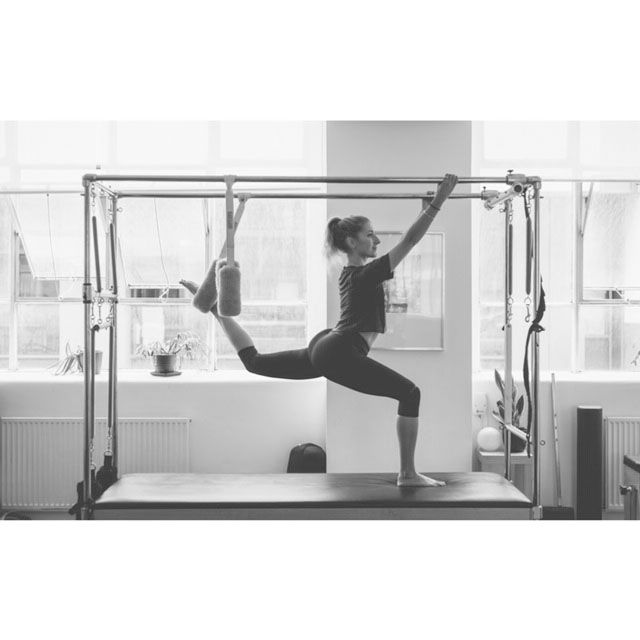
formerly hoxton square pilates
call us on 0207 251 8793
info@hoxtonpilates.com
pilates studio london


Fully equipped pilates studio with Cadillacs, Reformers, and a Wunda Chair

Intelligent movement that's tailored to you
Joseph Pilates pioneered his method in the early 20th century believing that a routine of mindful exercise is essential to maintain physical and mental wellbeing. He developed a strict regime of daily exercise to optimise both fitness and resilience.
In addition Pilates saw the value of resistance exercise for rehabilitation after injury. During World War I, he attached bed springs to the beds of wounded soldiers. With this innovation he developed unique exercises which hastened the patients' recovery to full strength and mobility.

Mat work exercise

Roll up exercise on the Pilates Cadillac

Abdominal challenge on the Wunda Chair
pilates classes
We are a fully equipped studio offering one-to-one sessions and semi-private classes. All of our instructors are fully certified and have a wealth of teaching experience.
contact us
Hoxton Pilates is located 2 minutes from Old Street station. Our location make us convenient for Shoreditch, Angel, Hackney, and the City of London.
These early efforts evolved into machines which graced his Manhattan studios in the 1920's. Today these spartan creations have changed very little, and the spring resistance is still the key to the method's effectiveness. The springs can produce a far more powerful exercise than gravity alone. Adding springs as one would add weight to a gym machine increases the effort required when pushing or pulling against resistance. In other situations an exercise with a very light spring can be more difficult to execute as it creates an unstable platform and requires increased core control. The flexibility of the spring resistance in tandem with the solid machinery provides scope to challenge aspects of strength and to nurture areas of weakness.
The most ubiquitous machine is the Reformer, with a moveable carriage that travels across gravity using steel springs of varying strengths to fine tune the load for each exercise. The apparatus most reminiscent of the "bed spring" device is called the Cadillac. This is a table with a large metal frame to which springs, handles and bars are attached. The next machine he developed was the Wunda Chair and this one evolved into a few different models in his lifetime. Its underlying principle was to invent a space saving device that everyone could use at home to achieve an effective full body workout. The original machine converted into a stylish Art Deco chair to compliment one's New York City apartment. The last piece of large studio equipment is the ladder barrel. This is inspired by the gymnastic "horse" used for the vaulting, reminding us that the method had a strong gymnastic element beyond basic fitness.
Much like the equipment, the Pilates method remains much the same too. In his book "Return to Life" Joseph Pilates outlines the principles that comprise the essence of his approach: concentration, core, balance, control, centering, precision, flow, efficiency, harmony, breathing. He called his technique "Contrology"and its aim is to optimise movement such that no single area of the body over works. “True flexibility can only be achieved when all muscles are uniformly developed.” (Joseph Pilates).
Pilates also recognised that optimal development is engineered from the inside out. This is what we have come to call "core strength". His system places a large emphasis on abdominal exercise, and promotes breath work utilising the entire abdominal wall and diaphragm. Moreover the full spectrum of the Pilates repertoire takes the body through its full range of motion, and the emphasis of each exercise is to move from ones centre. A consistent practice in this way promotes fluid effortless movement. There is harmony of balance, coordination, power and flexibility alongside the union of mind and body through the breath. The result is better strength, vitality, and resilience -- and it's never too late to start. “so too is the proper functioning of your own body the direct result of the assembled Contrology exercises that produce a harmonious structure we term physical fitness reflecting itself in a coordinated and balanced tripart unity of body, mind, and spirit. (Joseph Pilates)
What are Pilates studio classes?
In group reformer classes everyone in the room performs the same exercises at the same time at a fairly energetic pace. There is little opportunity for modification. In contrast, studio classes focus on the individual and are tailored to each person's needs on the day. Emphasis is on form and technique to maximise functional gain and minimise potential injury. Everyone works at their own pace and works towards their specific fitness goals. Furthermore there is the opportunity to use all the Pilates equipment as well as the matwork repertoire.
Should I opt for a private or semi-private session?
We recommend that everyone start with at least 2 private sessions. Our Introductory Package is comprised of an initial assessment and two private sessions at a reduced price. After this it's up to you. The semi-private session will still consist of the same exercises tailored to your needs, but there is less supervision. If you are carrying an injury or concerned about a specific condition you might decide on the increased attention of a 1-1 session. You can opt for private or semi-private instruction at any time.